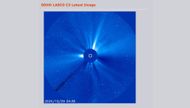Spooky season is upon us and so is the Headless Halloween Comet which is set to light up the sky from 28 October to 31 and could remain visible until December. Here's all you need to know about it.
What is the Headless Halloween comet?
The Headless Halloween Comet referred to as Comet ATLAS S1, was discovered on September 27, 2024, by astronomers at the ATLAS survey in Hawaii. It is a long-period comet originating from the Oort Cloud, populated with other such comets.
The term "headless" suggests that the comet lacks a significant "head" or coma—an extended atmosphere that typically forms around a comet's nucleus when it approaches the Sun.
The headless Halloween Comet is categorized as a Kreutz sungrazer, which means it is a type of comet that follows a highly elliptical orbit, allowing it to pass very close to the Sun, often within a few thousand kilometers of its surface.
As the comet approaches the Sun, it will heat up and can develop long tails of gas and dust, making them spectacular sights in the sky.
There is a high possibility that after its encounter with the sun, the comet could leave behind a tail without a visible nucleus if not destroyed.

When and where to watch the Headless Halloween Comet?
Later today, the headless Halloween Comet will reach its closest point to the Sun, known as perihelion, at approximately 746,000 miles (1.2 million kilometers), as reported by Sky & Telescope. This distance is quite close and could be potentially destructive for the comet.
The Halloween Comet can only be faintly seen from the Southern Hemisphere. However, it may become visible from the Northern Hemisphere in the mornings from October 29 through Halloween (October 31) and could remain visible until December, although this is not guaranteed.
NASA says the comet might be seen low in the eastern sky just before and after sunrise.
For people in the Washington, D.C. area, the comet will be visible above the horizon before dawn until October 31 as it gets closer to the Sun.
If it doesn’t break apart too much, it should also be visible with binoculars or a telescope from November 2 to December 19 while it moves away from the Sun. NASA astronomer Gordon Johnston mentioned this in a blog post.
NASA expects the comet could be brighter than -5 magnitude between 7 and 8 a.m. EDT. Brighter objects have lower positive numbers or higher negative numbers; for example, the full moon is -13, and Venus is -5. Usually, comets need to reach about +3 magnitude before they can be seen without binoculars.
Luckily, the Halloween Comet could be visible to the naked eye. While you don’t need advanced equipment to see it, using binoculars or a telescope can improve your chances of spotting this celestial object as it travels across the sky.
